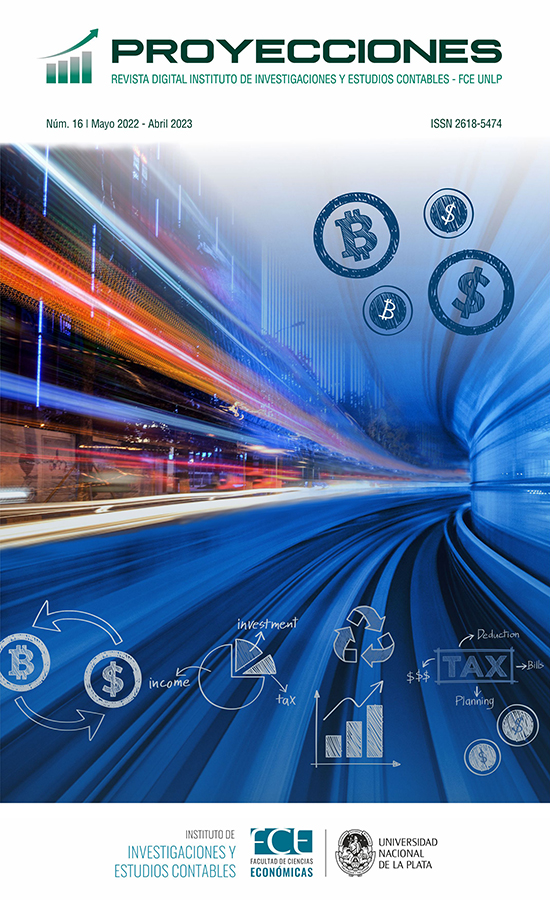Assets recognition in leasing contracts from the lessee´s point of view
DOI:
https://doi.org/10.24215/26185474e021Keywords:
leases, recognition, lessee accounting, implicit rate, discounted value, residual value, unguaranteed residual valueAbstract
Leasing contracts are used very frequently not only in Argentina but also worldwide. That is why it is very important to understand what accounting technical regulations stipulate the valuation at the very moment of its recognition when carrying out the periodical assets and liabilities measurements which emerge from the accounting of this type of contracts and the decrease of those.
We do not notice a deep analysis on a particular aspect related to the recognition of the underlying assets from the lessee´s point of view that has been the subject matter of the leasing contract.
There might be a lack of interest in analyzing deeply the determination of this present value with the implicit rate. It is because in the professional area it is very difficult and sometimes impossible to determine it. This is the reason why we base on the incremental liabilities rate to substitute those that cannot be estimated.
The use of this rate is considered in Argentinian accounting standards different from RT26 of the Federación Argentina de Consejos Profesionales de Ciencias Económicas (Argentine Federation of Professional Councils in Economic Sciences) (FACPCE), and in the recent model established on this topic in International Financial Reporting Standards (IFRS)16 of the International Accounting Standards Board (IASB, 2019). This is the main reason why we should consider this case.
Although the implicit rate is barely used, it should not be studied any longer or be removed from the accounting standards that suggest using it as it has few possibilities to be established or to be used in everyday professional activity.
This piece of work considers a theoretical analysis on some of the possible situations that can arise when applying this rate. We do not expect to call attention to those who have to account the effects of this type of contract during their work.
Nevertheless, it has not prevented us from performing academic practice to analyze and to study each and every situation that could emerge.
We hope to bring up the use, the reason and the fact of this rate to account the effects derived from the financial leasing contracts.
Downloads
Metrics
References
Consejo de Normas Internacionales de Contabilidad (IASB). (2003). NIC 17, Arrendamientos. Recuperado el día 5 de enero de 2021 de, http://www.facpce.org.ar:8080/miniportal/archivos/nic/nic17.pdf
Consejo de Normas Internacionales de Contabilidad (IASB). (2019). NIIF 16, Arrendamientos. Recuperado el 20 de mayo de 2021 de, https://www.facpce.org.ar/
Federación Argentina de Consejos Profesionales de Ciencias Económicas (FACPCE). (2000a). RT17, Normas contables Profesionales: desarrollo de cuestiones de aplicación general. Recuperado el 20 de junio de 2021 de https://www.facpce.org.ar/
Federación Argentina de Consejos Profesionales de Ciencias Económicas (FACPCE). (2000b). RT18, Normas contables Profesionales: desarrollo de algunas cuestiones de aplicación particular. Recuperado el 20 de junio de 2021 de https://www.facpce.org.ar/
Federación Argentina de Consejos Profesionales de Ciencias Económicas (FACPCE). (2009). Informe Nº27- Área de Contabilidad. Recuperado el 5 de abril de 2021 de https://www.facpce.org.ar/
Bibliografía
Carbajo Vasco, D., Días Echegaray, J. y Serrano Moracho, F. (2017). Arrendamientos financieros y operativos tras la NIIF16. Tirant lo Blanc
Castro, A. (2017). Análisis del contrato de leasing desde el punto de vista de su realidad económica. Revista facultad de ciencias económicas UNCUYO, (131).
Fowler Newton, E. (2010). Contabilidad Superior. La Ley
López Herrera, D. (2000). Problemática contable del leasing. Recuperado el 7 de abril de 2021 de hhtp://www.5campus.com/lección/cf012
Martínez J. (2018). Contabilidad de los arrendamientos. Independently published
Simaro, J., Tonelli, O. y Othar, J. (2003). Tratamiento contable del leasing. En Anuario Nº1. Centro de Estudios Contables, Facultad de Ciencias Económicas Universidad Nacional del Centro, Tandil.
Vergara Pallas, J. C. (2010). Leasing financiero [Trabajo de investigación]. Universidad del Aconcagua, Facultad de ciencias económicas y jurídicas. http://bibliotecadigital.uda.edu.ar/objetos_digitales/361/seminario-1541-leasing.pdf
Vicente Díaz, M. (2020). Los arrendamientos. La ley.
Additional Files
Published
How to Cite
Issue
Section
License
Copyright (c) 2022 Juan Carlos Martin

This work is licensed under a Creative Commons Attribution-NonCommercial-NoDerivatives 4.0 International License.
El material publicado en la revista se distribuye bajo una licencia de Creative Commons de Atribución-NoComercial-SinDerivadas 4.0 Internacional (CC BY-NC-ND 4.0). Esta licencia obliga a otros a dar crédito de manera adecuada, brindar un enlace a la licencia, e indicar si se han realizado cambios; no permite hacer uso comercial de la obra; y si se remezclara, transformara o creara otro material a partir de la obra, no podrá ser distribuida esa modificación.




























